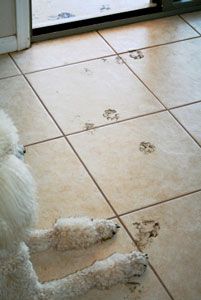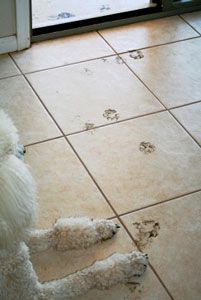Introduction

How to Clean Dog Paws After Walks : Daily walks are essential for your dog’s physical health and mental stimulation. However, with every walk, your dog’s paws collect dirt, mud, allergens, chemicals, and sometimes even dangerous debris. Just like you’d wash your hands after coming home, it’s equally important to clean your dog’s paws after every walk.
In this comprehensive guide, we’ll walk you through why it’s important, step-by-step cleaning methods, paw care tips, recommended products, and much more. If you want your pet to stay healthy and your home to stay clean, this article is for you!
Why Should You Clean Your Dog’s Paws After Walks?
Before diving into the how-to, let’s understand the “why.”
1. Health & Hygiene
Dirt, bacteria, and allergens cling to your dog’s paws. Not cleaning them can lead to skin infections, itching, or worse.
2. Avoiding Toxins
Your dog might step on pesticides, road salt, or chemicals which can be toxic if licked off.
3. Protect Your Home
Unwashed paws bring mud and grime into your house—onto your floors, carpets, and furniture.
4. Paw Inspection
Cleaning time gives you a chance to inspect for injuries, ticks, or thorns.
When Should You Clean Your Dog’s Paws?
| Condition | Action |
|---|---|
| Muddy walk or rain | Deep cleaning with water and soap |
| Snowy or icy roads | Rinse with warm water (road salt alert) |
| Dusty or dry sidewalks | Wipe with dog wipes or damp cloth |
| Grassy or wooded area | Check for ticks and wash gently |
| Urban streets (chemicals) | Full clean with paw cleaner |
Methods to Clean Dog Paws After Walks
Here are several techniques based on convenience and mess levels:
1. Use a Dog Paw Washer
A dog paw washer is a portable container with soft bristles inside. Add some water, dip each paw, twist gently, and pat dry.
Pros:
- Deep cleans between pads
- Great for muddy paws
Product Tip: Try the Dexas MudBuster Paw Cleaner
2. Damp Cloth or Dog Wipes
For quick walks or dry conditions, a dog-safe wipe or damp microfiber cloth works well.
Instructions:
- Wipe each paw thoroughly
- Focus on pads and between toes
Caution: Avoid baby wipes as they contain harmful chemicals.
3. Warm Water Soak
Ideal for snow, road salt, or sand.
Steps:
- Fill a basin with lukewarm water.
- Soak each paw for 15–30 seconds.
- Pat dry with a towel.
4. Dog-Friendly Soap and Rinse
If the paws are very dirty or have visible mud:
Steps:
- Wet the paw
- Apply dog shampoo (not human soap!)
- Lather and rinse
- Dry thoroughly
5. Paw Spray Sanitizers
These are anti-bacterial and quick-drying. Great for in-between walks.
Best For: Apartment dogs and quick cleaning.
Step-by-Step: Post-Walk Paw Cleaning Routine
- Prepare a Cleaning Station
- Keep it near the entrance
- Place a towel, wipes, and cleaner
- Check for Debris
- Look for sticks, pebbles, or glass
- Wipe or Wash
- Depending on the condition (see table above)
- Dry Thoroughly
- Moisture between toes can cause fungus
- Apply Paw Balm (Optional)
- Especially in winter or summer for hydration
Homemade Dog Paw Cleaning Solutions
If you prefer DIY or want to avoid chemicals, try these:
1. Apple Cider Vinegar Solution
- 1 part ACV, 2 parts water
- Natural disinfectant
- Do not use on open wounds
2. Salt-Free Soak
- Warm water with a few drops of coconut oil
- Softens and disinfects
3. Baking Soda Rinse
- 1 tbsp in 1 cup water
- Neutralizes odor
Tips for Better Paw Care
- Trim Paw Hair: Prevents buildup of mud and debris.
- Clip Nails Regularly: Long nails can split and cause pain.
- Moisturize Paws: Use dog-safe balm to prevent cracks.
- Avoid Hot Pavements: If it’s too hot for your hand, it’s too hot for their paws.
- Use Dog Boots in Harsh Weather: Protects from snow, salt, or hot surfaces.
What Not to Use on Dog Paws
- Human soaps/shampoo
- Alcohol wipes
- Essential oils (undiluted)
- Disinfectant sprays meant for surfaces
Dog Paw Cleaning Table: Quick Comparison
| Method | Best For | Time Needed | Supplies Needed |
|---|---|---|---|
| Dog Paw Washer | Muddy walks | 3–5 mins | Washer, water |
| Wipes/Damp Cloth | Daily cleanups | 1–2 mins | Dog wipes or soft towel |
| Warm Water Soak | Salt, snow, sand | 5 mins | Basin, warm water |
| Soap and Rinse | Very dirty paws | 5–10 mins | Dog shampoo, towel |
| Paw Sanitizer Spray | Urban or fast walks | <1 min | Dog paw spray |
Common Problems & Solutions
| Problem | Solution |
|---|---|
| Paw smells bad | Check for infection, clean thoroughly, apply antifungal balm |
| Dog hates paw washing | Use treats and calming voice, try wipes instead of soaking |
| Cracked paw pads | Use dog paw balm regularly |
| Licks paws constantly after walk | Rinse well to remove allergens or chemicals |
| Mud in-between toes | Use dog paw washer or toothbrush for deep cleaning |
Frequently Asked Questions (FAQ)
Q1: Is it OK to wash my dog’s paws every day?
Yes, but use gentle methods like water-only rinses or wipes unless visibly dirty.
Q2: Can I use baby wipes on my dog’s paws?
No. Many baby wipes contain alcohol and fragrance that can irritate dog skin. Use pet-safe wipes only.
Q3: What’s the best way to clean muddy paws?
Use a dog paw washer or warm water and mild dog shampoo, followed by a clean towel dry.
Q4: How do I stop my dog from tracking dirt into the house?
Keep a cleaning station at the door and use dog booties in bad weather.
Q5: What’s a quick fix if I’m short on time?
Keep pet-safe wipes or a paw spray near the door for fast cleanup.Related Articles
✅ Remove Pet Odors Naturally: Complete Guide
Final Thoughts
Keeping your dog’s paws clean after walks is not just about hygiene—it’s about health, comfort, and cleanliness for both your pet and your home. Whether you use wipes, a paw washer, or good old-fashioned soap and water, the key is consistency.
Taking just 5 minutes after each walk can prevent infections, reduce allergens, and keep your home paw-print free. Make it part of your routine, and both your dog and your house will thank you.
